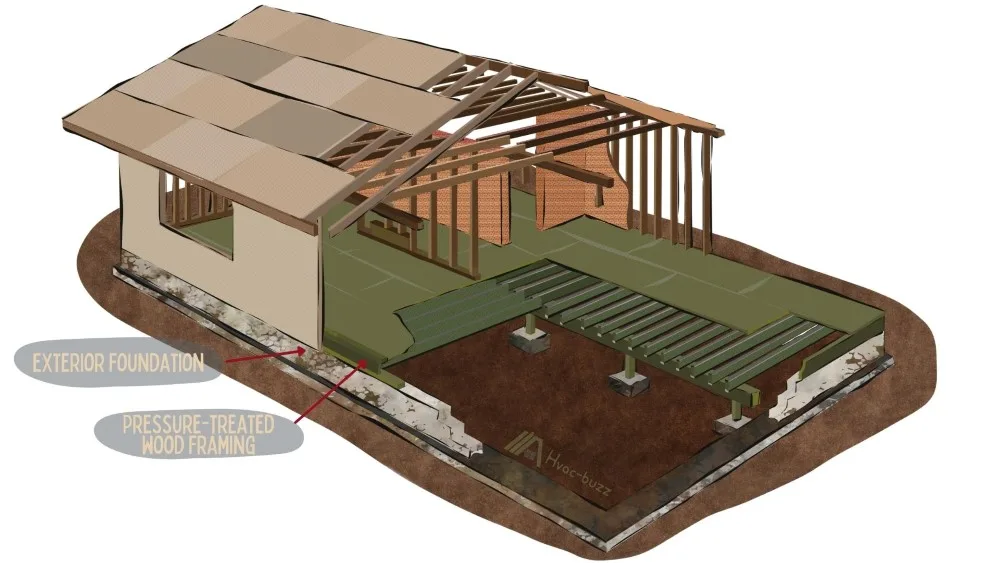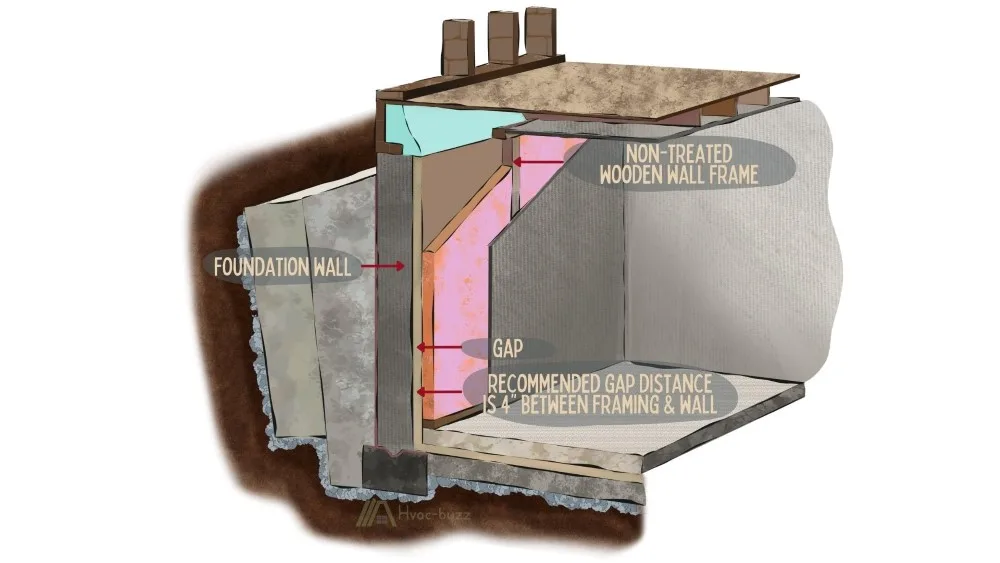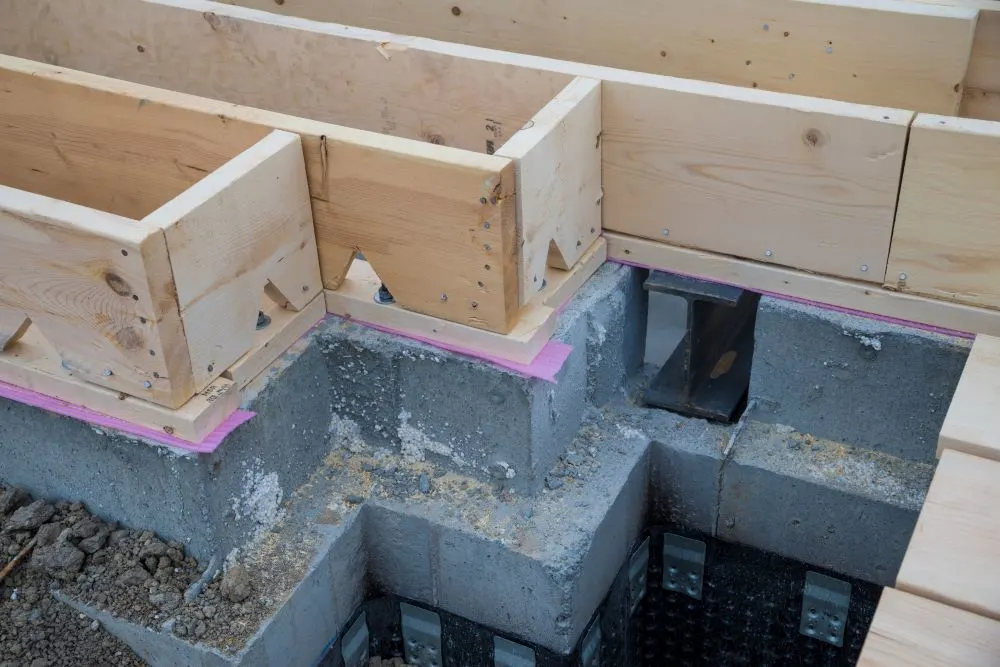Gap Betwixt Basement Wall And Framing
When it comes to the biggest job with having a basement, about tin concord that moisture is in all likelihood the worst. There are many things that tin can live done to reduce wet inwards the basement, only around are expensive together with hard. One fashion to trim moisture has to do alongside the construction of the basement’second walls together with can be executed right at the kickoff of your building procedure: gaps between the framing and your basement’second walls.
The purpose of the gap is unproblematic; it prevents wet inwards the basement’sec masonry wall from coming into contact with the wooden frame. However, in that location are alternatives to the gap, then why go for the gap? Here, nosotros look at what the building code says (because it’second e'er the outset home 1 should get-go), and so nosotros volition get through the details too pros together with cons of the gap, as well as lastly, we end with a comparing of a gap and the principal alternative to aid y'all brand your conclusion.

A gap between a basement wall in addition to framing will fulfil its role of preventing the woods frame from absorbing wet from the foundation wall. It is vital if the framing forest is non preservative treated. But, comparison a gap to treated woods amongst no gap reveals that treated wood is the better pick.
Is Gap Between Wall too Frame Compulsory?
The use of the gap is to furnish physical distance between the foundation walls together with the woods framing, then moisture cannot be transferred. This protects the integrity of the framing and ensures that the construction work is long-lasting.
This is a real important part of edifice in a basement. However, as per the International Residential Code (IRC), a gap between your wall together with frame is not explicitly necessary. But why? Well, let’s await at what the IRC says.
Section R317.one of the IRC talks virtually where wood must live protected from decay past using naturally durable wood or preservative-treated forest. Point ii inward this list says the following:
“Wood framing members, including columns, that rest straight on concrete or masonry exterior foundation walls in addition to are less than eight inches (203 mm) from the exposed ground.”
So, while the IRC does not explicitly enjoin that y'all make or make non demand a gap betwixt the masonry walls too the frame, we can deduce from the in a higher place section that wooden frames tin can directly balance on the masonry walls provided they are protected from wet.
Alternatives to a Gap
Pressure-treating is the process of injecting a preservative into the forest by using high pressure level. This preservative protects against wet as well every bit insects.
Since wet in addition to insects are particularly injurious to woods, protecting forest against them greatly increases the lifespan and durability of forest. The lifespan of pressure-treated forest can span decades.

Naturally durable forest is brought upwards past the IRC, just what just is it? Natural durability refers to woods’second ability to fend off fungi decay also as insect attacks. How naturally durable a type of forest is volition depend on the place, age, in addition to growing weather of the wood.
Either force per unit area-treated wood or naturally durable wood should be used for the framing of your basement wherever it is inward contact amongst the ground or exterior foundation walls, only a gap between your framing in addition to walls is non required past edifice codes.
Recommended Gap Dimensions
If you lot’d even so like a gap betwixt your framing together with wall, the recommended distance is almost 4″ betwixt the framing as well as your basement wall.
Leaving a gap between your framing in addition to walls provides a home for humidity to be trapped so that it does not move into the master role of your basement through the walls.
Direct contact between the framing together with the walls tin Pb to slow cause of moisture to the walls. This moisture tin can infiltrate your basement. It is i of the causes of basement humidity.

To limit this wet migration, iv″ is just the correct distance.
Too big of a gap (beyond iv″) would waste matter building material for a infinite that isn’t used or needed too tin can besides increase the likeliness of larger animals living inwards this space since at that place is room for them.
Are Vapor Barriers Necessary With Gaps?
In connection to where moisture-resistant woods are required, Section R317.i.6 of the IRC states:
“Wood structural members supporting wet-permeable floors or roofs that are exposed to the atmospheric condition, such every bit concrete or masonry slabs, unless separated from such floors or roofs by an impervious wet barrier.”
This specification is referring to what locations of the home must have naturally durable wood or preservative-treated wood as framing.
The framing of a basement would fall under “wood structural members supporting wet-permeable floors or roofs that are exposed to the atmospheric condition.”
Because of this, the framing must be either naturally durable or preservative-treated, or at that place must live a vapor barrier installed betwixt the framing too the basement wall.
The edifice code specification is not specific to gaps between framing together with walls, though.
The agreement is that a gap is a sort of moisture barrier inside itself. It is non foolproof, though. Moisture can still gather in the gap as well as infiltrate the walls. In this example, a vapor barrier would live very useful.
Benefits of the Gap
Even if a gap is not required past building codes, it can live highly useful inward controlling both the humidity in addition to temperature of your basement.
Limiting Moisture
Water tin can seep into the framing together with move to the walls of your basement when in that location is directly contact between the framing together with walls. A gap of the right size can cease this completely.
Deterring Water Leakage
A big plenty gap betwixt framing as well as walls tin can also be useful inward the outcome of big amounts of H2O leaking. The space would be bully for trapping said H2O. Without a gap, the water could easily spread into your basement or other areas of your dwelling.
Controlling Temperature
A gap tin can serve every bit an intermediate between the harsh temperatures of the outdoors together with your home. For case, inward the wintertime, it will live warmer than directly outdoors merely colder than the habitation.
This is energy-efficient since your basement wouldn’t necessarily live inward straight contact with the outdoors. The gap would serve as a barrier, and and then the insulation of the basement, likewise as the heating/cooling unit of measurement, would do the balance of the work.
Drawbacks of the Gap
Loss of Space
When you opt for installing the framing with a gap between the wood as well as the foundation wall, y'all are losing floor expanse. While this may non live problematic when y'all are simply framing perimeter walls, as before long as y'all kickoff to subdivide the basement, the four″ gaps add together upward.
Pest Problems
Although four″ isn’t much space for nearly creatures, this is plenty enough room to alive for approximately. Small rodents and insects mightiness find the gap between your wall and the framing a quite pleasant home to live.
This gap would provide shelter from extreme temperatures, pelting, as well as wind. It would as well be relatively undisturbed past humans since access to it isn’t readily available.
With these factors inward consideration, this gap power test too tempting to alive inward for invading critters.
Evicting these pests would too prove a problem, since, as said earlier, the gap is non easy to access. Opening up this space would postulate repairs downward the business as well as would hateful that the invaders could escape into your dwelling.
Flooding
A benefit of a gap between the framing in addition to the walls of your basement would be that it would protect the balance of the basement together with house from flooding, potentially. But at that place are more or less cons that go alongside this also.
Water that does enter this gap volition non be easy to drain. The gap must live breached and drained.
The H2O stuck inward the gap would either leak exterior or worse, into your basement. If H2O stays in the gap too long, it tin structurally harm the framing, reducing its integrity too every bit its lifespan.
Gap vs Pressure Treated Wood
So, if you lot tin can take a gap or preservative-treated forest for interior framing, which should you select?
In price of cost, a gap is going to be more affordable. Preservative-treated or naturally durable forest are more than expensive to purchase. There is likewise the added expense of resealing edges where they are cut to size.
As a side Federal Reserve note here, I wanted to bring up that I of late found out that Home Depot will cut your wood for y'all, even if it is pressure treated!
However, the masonry wall of a basement is not the solely origin of wet inward these rooms, then preservative-treated forest would protect your framing from all sources of wet, while the gap solely protects it from the foundation walls themselves.
The preservative injected into the wood heightens the integrity of the wood itself. It is less likely to live damaged by H2O as well as insects because of this. It has no issue on limiting humidity, though.
This is mainly for the structural integrity of the woods, though, non to prevent humidity in the basement. It tin can assist a scrap, though, since not every bit much H2O will live kept inwards the wood since it isn’t as permeable. This limits the migration of the water in the framing to the basement walls, which non exclusively protects your basement walls just too the household inward full general every bit damp basements tin impact the upstairs.
Furthermore, the process of treating the woods makes it more than resistant to non-moisture-related impairment. Thus, inwards this respect, a preservative-treated or naturally durable woods is going to be the more long-lasting pick.

A gap is non going to live resistant to insects, such every bit termites, while preservative-treated forest is resistant to insects. In fact, the four″ gap creates a space for whatsoever number of pests to occupy within your walls without you beingness aware until you lot are overrun.
One final signal of comparison is the infinite that yous lose amongst having a gap. While 4″ does not look like much, when it is four″ inward four walls, it adds upward. Basements are normally big spaces, so this power be a moot bespeak, merely it is worth mentioning.
Another indicate worth mentioning is that preservative-treated woods is of import for the strength of your framing, just it is non a foolproof method of limiting the amount of wet entering a basement since the framing is still inward straight contact alongside the walls. A gap or vapor barrier can do this.
Sources
https://www.talbertbuildingsupply.com/web log/when-should-1-role-force per unit area-treated-lumber
https://www.thespruce.com/pressure level-treated-woods-code-requirements-1822480
https://www.sciencedirect.com/topics/applied science/natural-durability
https://validhouse.com/gap-between-basement-wall-as well as-framing/

Comments
Post a Comment